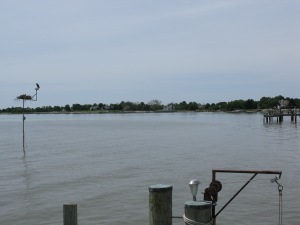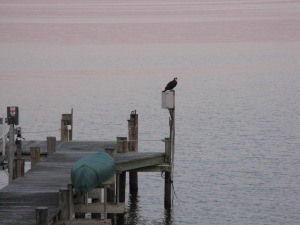Good morning from the bright, sunny, warm and breezy Eastern Shore! Tom is sitting on the camera, Audrey is busy feeding her chicks and all is well from the secret Ospreycam location.
Just a few quick notes this morning while we watch and wait for chick #3. As I am writing this, there are creaking and bumping noises coming over the live sound feed on the camera. You probably hear these sounds with some frequency and have wondered what is making those weird noises, which almost sounds like an old sailing ship creaking in the wind and waves. Well, these noises are from our good friend Tom when he lands and sits on the camera. We posted some photographs in the last blog which showed the camera set-up in relation to the nest. One of Tom’s favorite places to hang out is on top of the camera, and he just left there a few minutes ago after bringing breakfast to Audrey and the kids.
An interesting behavior you may want to watch for is when the adult ospreys are walking around the nest. When doing this, the adult ospreys will usually curl in their talons, so as not to accidentally spear something that shouldn’t be speared, like an osprey chick or egg. Talon spearing should be for fish only, and the adults do seem to look out for the little ones and eggs while walking in the nest. We have observed this behavior since our first camera was installed by Crazy Osprey Man in 2002.
There was a question posted on the Conservancy’s Facebook page asking about a third osprey sometimes visiting the nest. There are several other osprey poles/nests in our area, and we see different ospreys flying over quite frequently. Tom and Audrey know when there is an outsider flying near their nest, and will sound the alarm quite vocally at any interlopers. We have seen visiting ospreys fly down very close to the nest and attempt to land. It doesn’t take long for the interloper to realize they are not welcome, and take off. Sometimes Tom will even physically engage the interloper, and chase the unwanted osprey off. As many, many ospreys have been raised in our nest during the 18 years we have hosted our friends, we theorize that the visitors may be adult ospreys that were just visiting their first home. Dr. Spitzer’s research indicates that the offspring generally return to the area of the original nesting site. According to other reading we have done, the second summer after hatching is when the young adults will return to their old neighborhood. So if you hear a lot of squawking and noise going on while Tom and Audrey are looking up, there is most assuredly an osprey visitor going by. If you happened to be watching the camera earlier today, this was the case around 9:30 this morning. We heard a lot of noise from outside (there is a 7 second delay in the camera transmissions after the live action occurs, so we hear what is happening before it is transmitted by the camera), and saw another osprey flying over. From the subsequent camera transmission, both Tom and Audrey could be seen looking up and fussing at the passer-by.
One last thing before we close for today regarding the technical upgrades that were happening on Wednesday afternoon. We appreciate everyone’s concern about bothering Tom, Audrey and the chicks, but please know these upgrades were happening inside the house and not at the nest. The camera just happened to freeze at an instant when the chicks appeared to be by themselves, but they were not. Audrey was right there, just not in camera view. We have been incredibly fortunate to have been able to view our magnificent friends up close and personal for many, many years. This osprey pair, and our original Tom and Audrey osprey pair who graced our nest for 15 years, are like family to us. We would never do anything to harm or intentionally upset our little osprey family. We are glad to be able to share our 18 years of observations and experience with all of the camera viewers out there, and hope the lives of our osprey family will bring you all as much joy, fun and amazement at the wonders of nature as we have had all of these years.
ALERT! ALERT! Just as we were getting ready to post the above blog, a seaplane landed right behind our house, and passed just behind the pole! Both Tom and Audrey were in the nest at the time, and were looking at the visitor with some trepidation. Tom made a great decision not to try to chase this rather large and loud interloper away, and stayed with Audrey in the nest, wondering what the mother of that bird had been feeding it.
Until next time,
Crazy Osprey Man and Mrs. Crazy Osprey Man
If you are enjoying the osprey camera and blog, please consider a donation to the Chesapeake Conservancy so they are able to continue supporting programs such as this one. Go to www.chesapeakeconservancy.org today. Thanks very much!





